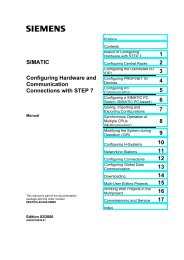II - DCE FEL ČVUT v Praze
II - DCE FEL ČVUT v Praze
II - DCE FEL ČVUT v Praze
Create successful ePaper yourself
Turn your PDF publications into a flip-book with our unique Google optimized e-Paper software.
SIMATIC S7 Ex Analog Modules<br />
Operating<br />
principle of<br />
thermocouples<br />
Extension to a<br />
reference junction<br />
Use of<br />
thermostatically<br />
controlled terminal<br />
boxes<br />
Compensation of<br />
thermocouples<br />
External<br />
compensation<br />
3-26<br />
If the measuring junction is subjected to a different temperature than at the<br />
free ends of the thermocouple (connection point), a voltage, i.e. the thermal<br />
e.m.f. is produced between the free ends.<br />
The value of the thermal e.m.f. depends on the difference between the<br />
temperature at the measuring junction and the temperature at the free ends as<br />
well as on the type of material combination used for the thermocouple. Since<br />
a temperature difference is always recorded with a thermocouple, the free<br />
ends must be kept at a known temperature at a reference junction in order to<br />
determine the temperature of the measuring junction.<br />
Thermocouples can be extended from their connection point by equalizing<br />
conductors up to a point with known temperature (reference junction).<br />
The material of the equalizing conductors has the same thermal e.m.f. as the<br />
wires of the thermocouples. The conductors leading from the reference<br />
junction up to the analog module are made of copper.<br />
It is possible to use temperature-compensated terminal boxes. Use boxes with<br />
reference junction temperatures of 0 C or 50 C when using<br />
thermostatically controlled terminal boxes.<br />
External or internal compensation can be adopted depending on where<br />
(locally) you require the reference junction.<br />
In the case of external compensation, the temperature of the reference<br />
junction for thermocouples is taken into consideration by means of a<br />
compensation box or thermal resistor.<br />
In the case of internal compensation, the internal terminal temperature of the<br />
module is used for the comparison.<br />
The temperature of the reference junction can be compensated by means of a<br />
compensating circuit, e.g. by a compensation box.<br />
The compensation box contains a bridge circuit which is calibrated for a<br />
certain reference junction temperature (compensating temperature). The<br />
terminal connections for the ends of the equalizing conductor of the<br />
thermocouple form the reference junction.<br />
If the actual reference temperature deviates from the compensating<br />
temperature the temperature-dependent bridge resistance will change. A<br />
positive or negative compensation voltage is produced which is added to the<br />
thermal e.m.f.<br />
Compensation boxes with a reference junction temperature of 0 C must<br />
be used for the purpose of compensating the analog input modules.<br />
A further external compensation option is to record the reference junction<br />
temperature with a thermal resistor in the climatic range (e.g. Pt 100).<br />
I/O Modules with Intrinsically-Safe Signals<br />
C79000-G7076-C152-04
















